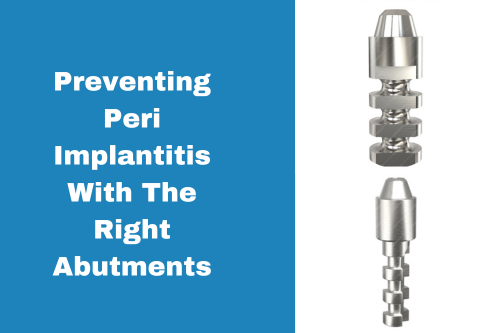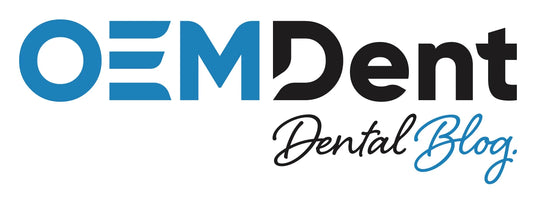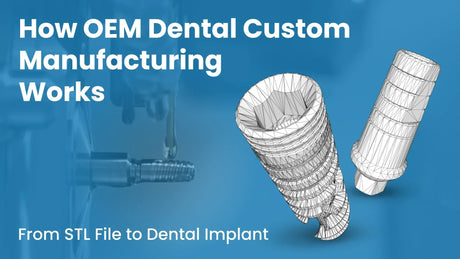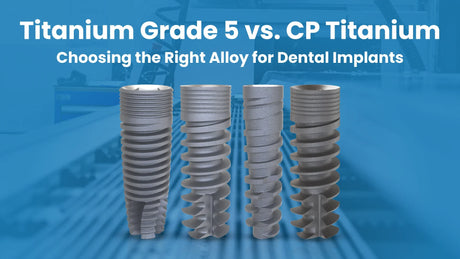

How to Prevent Peri Implantitis - The Role of Abutment Surface Design and Materials
For years, dental implants have been a game changer in restorative dentistry. They’ve given patients a second chance at a full, functional smile. But let’s be real - no matter how well an implant is placed, if peri implantitis develops, everything is at risk.
We’ve all seen it. A patient comes in months or years after their implant placement, complaining of bleeding, inflammation, or discomfort around the site. The X ray reveals bone loss around the implant, and suddenly, what was once a stable restoration is now at risk of failure.
Peri implantitis is one of the biggest challenges in implant dentistry. It can start with minor inflammation but quickly escalate to serious bone loss, leaving no option but to remove the implant altogether.
But here’s the thing - it’s preventable.
And one of the biggest factors in prevention? The abutment itself.
The surface design and material of the abutment play a major role in soft tissue health, bacterial adhesion, and long term implant success. Choosing the right one could mean the difference between a healthy, functional implant and one that fails over time.
So let’s take a closer look at what really causes peri implantitis and how the right abutment can help keep implants healthy for life.
Why Peri Implantitis Happens - And Why It’s a Big Problem
Peri implantitis is often compared to periodontitis, but there’s a major difference - implants don’t have the same defense system as natural teeth.
A natural tooth has periodontal ligaments that help fight off bacteria and infection. An implant, on the other hand, relies completely on the surrounding soft tissue to stay sealed and protected. If bacteria manage to get underneath that tissue, they attack the bone directly.
And once bone loss starts, it’s extremely difficult to stop.
Some of the biggest causes of peri implantitis include:
-
Bacterial buildup around the abutment
-
Poor soft tissue attachment to the abutment surface
-
Excess cement from cement retained restorations
-
Micromovement of the abutment, creating a gap for bacteria
-
A rough or porous abutment surface that traps plaque
This is where abutment design and material selection become critical. A poorly designed or low quality abutment can increase the risk of bacterial buildup, leading to chronic inflammation and eventual bone loss.
But the right abutment can create a healthier environment for the soft tissue, reducing bacterial attachment and lowering the risk of peri implantitis.
How Abutment Surface Design Affects Implant Health
Not all abutments are created equal. The surface of an abutment plays a direct role in how well soft tissue attaches and how resistant it is to bacterial colonization.
Smooth vs. Rough Abutment Surfaces - What Works Best?
A rough or porous abutment surface might seem like a good idea for tissue attachment, but it actually traps bacteria and makes plaque removal harder. Studies have shown that a smoother surface leads to less bacterial accumulation, reducing inflammation around the implant.
A polished or machined abutment surface helps prevent plaque from sticking and makes it easier for the patient to maintain good oral hygiene. The goal is to create an environment where bacteria can’t easily attach, reducing the risk of infection.
That’s why high quality titanium and zirconia abutments often have a machined, smooth finish - to minimize bacterial buildup and support long term soft tissue health.
Why the Abutment’s Connection to the Implant Matters
Another major factor is how well the abutment connects to the implant.
-
A poor connection leaves gaps, allowing bacteria to sneak in and settle beneath the soft tissue.
-
A precise, tight connection prevents microleakage, reducing bacterial colonization at the implant abutment interface.
This is why high quality CNC milled abutments are preferred over lower cost alternatives. A well machined abutment ensures a perfect fit, eliminating tiny spaces where bacteria could thrive.
The Best Abutment Materials for Peri Implant Health
The material of the abutment plays just as big of a role in preventing peri implantitis as the surface design. Some materials are more biocompatible, meaning they allow soft tissue to heal and attach better, while others may trigger inflammation.
Titanium Abutments - The Gold Standard
Titanium abutments are still the most widely used option because they are:
-
Highly biocompatible - They integrate well with soft tissue and bone.
-
Corrosion resistant - They do not break down in the oral environment.
-
Strong and durable - They provide excellent long term stability.
However, one downside is that titanium can sometimes cause slight discoloration of the soft tissue, especially in cases where the tissue is thin.
Zirconia Abutments - The Aesthetic and Biocompatible Choice
Zirconia abutments are becoming more popular, especially for esthetic cases in the anterior region. They offer:
-
A natural tooth colored appearance - No gray shine through thin tissue.
-
High biocompatibility - Soft tissue responds well to zirconia, reducing inflammation.
-
A smooth, plaque resistant surface - Less bacterial accumulation compared to rougher materials.
The only drawback of zirconia is that it’s not as strong as titanium, so it may not be the best option for high load areas like molars.
How to Reduce the Risk of Peri Implantitis in Your Cases
By choosing the right abutment surface and material, you can significantly reduce the risk of peri implantitis. Here’s how:
-
Use a smooth, polished abutment surface to prevent bacterial buildup.
-
Choose titanium for strength or zirconia for esthetics and biocompatibility.
-
Ensure a precise implant abutment connection to prevent microleakage.
-
Consider using screw retained restorations to avoid excess cement.
-
Educate patients on oral hygiene to keep bacteria from accumulating around the implant.
By focusing on these factors, you give your patients the best possible chance of maintaining a healthy, long lasting implant.
The Future of Implant Abutments - Designed for Health and Longevity
At OEMDent, we understand how important abutment design and material selection are in preventing peri implantitis. That’s why we offer a full range of high precision titanium and zirconia abutments, designed to reduce bacterial attachment, improve soft tissue response, and enhance long term implant success.
If you’re looking for better solutions to improve implant health, explore our collection of premium abutments and see how the right choice can make all the difference.
Because when it comes to implant longevity, every detail matters.

OEMDent.com offers uncompromised quality, cost-effective dental implants & prosthetics compatible with leading implant systems. We go beyond manufacturing, offering OEM & Private Label services to meet your dental needs.






